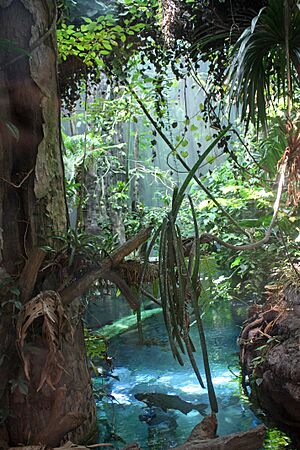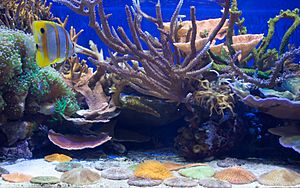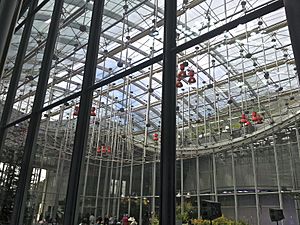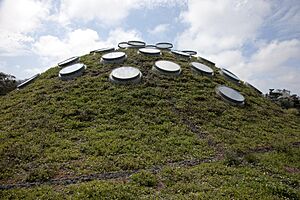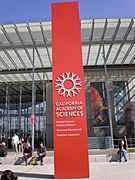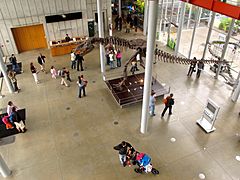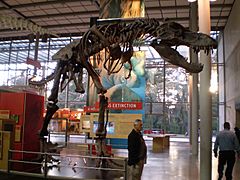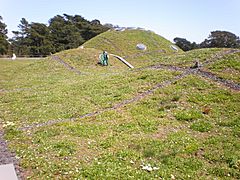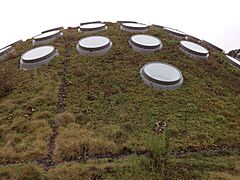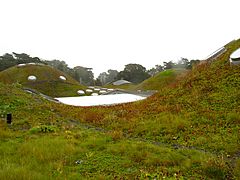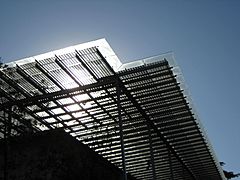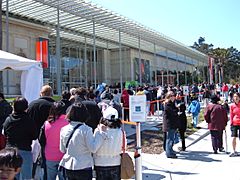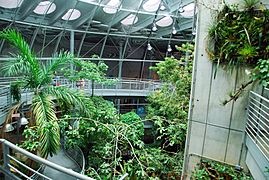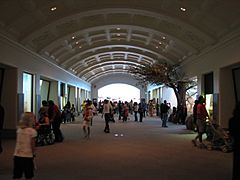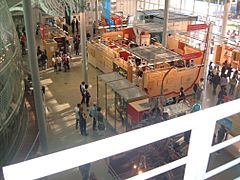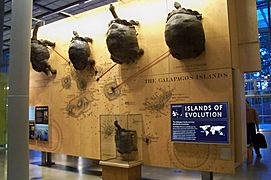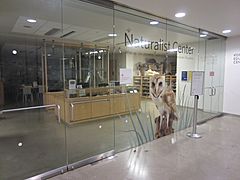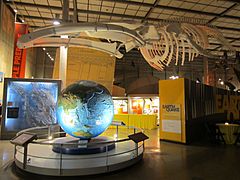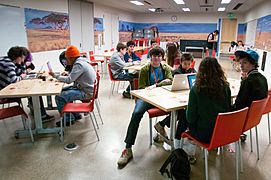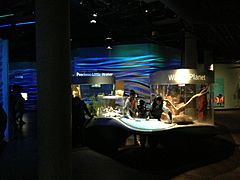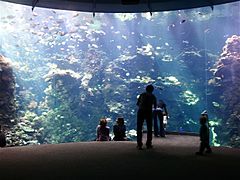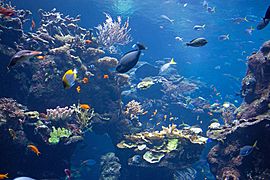California Academy of Sciences facts for kids
 |
|
 |
|
| Established | 1853 |
|---|---|
| Location | Golden Gate Park San Francisco, California, United States |
| Type | Natural history |
| Accreditation | AAM ASTC |
| Visitors | 1.34 million (2016) |
| Architect | Renzo Piano |
| Public transit access |
|
The California Academy of Sciences is a super cool place in San Francisco, California. It's a huge natural history museum and a research center all in one! Imagine a place with over 46 million amazing specimens. That's a lot of plants, animals, and rocks!
The Academy started way back in 1853. It was a group of scientists who wanted to study nature. Today, it still does a lot of important research. The main building in Golden Gate Park was completely rebuilt in 2008. It's a massive building, covering about 40,000 square meters.
Contents
How the Academy Works
The California Academy of Sciences is the oldest museum and research place for natural sciences in California. It's run by a group of 41 people called the board of trustees. These trustees are chosen by special members called "Fellows." The Fellows are scientists nominated by their friends and chosen by the board. They are members for life! The board then picks the leaders who manage the Academy every day.
Science Behind the Scenes
Besides being a public museum, the Academy also has a special research part. It's called the Institute for Biodiversity Science and Sustainability (IBSS). This group studies how living things are related and how to protect them. You can see some of their work in the museum's "project lab" exhibit. But most of their research happens in labs hidden from public view. Almost half of the Academy's building is used for research and offices!
Awesome Exhibits to Explore
The museum is all about natural history. Here are some of the amazing things you can see:
- Kimball Natural History Museum – This is most of the museum! It has the Africa Hall, which is the Academy's oldest exhibit. There's also a cool swinging ball called a Foucault pendulum. You can learn about Earth's geology and other science topics here.
- Morrison Planetarium – Get ready to blast off! This planetarium has a huge dome, 27 meters wide. It shows amazing digital shows about space and stars.
- Rainforests of the World – Step into a real rainforest! This exhibit is inside a giant 27-meter glass dome. You'll feel like you're in a tropical forest.
- Steinhart Aquarium – Dive into the ocean! This aquarium has beautiful coral reefs, tide pools, and even swamp habitats.
- Penguin Habitat – Say hello to the penguins! This area is home to a colony of African penguins.
The Academy also has many educational programs for everyone.
Important Research
Scientists at the Academy's Institute for Biodiversity Science and Sustainability do important research. They study many fields, like anthropology (people and cultures), marine biology (ocean life), botany (plants), entomology (insects), herpetology (reptiles and amphibians), ichthyology (fish), and paleontology (fossils).
They focus a lot on protecting the environment and all living things. Academy researchers travel all over the world. For example, in 2011, they went to the Philippines and found about 300 new species! The Academy also publishes scientific journals to share its discoveries.
A Look Back in Time: History of the Academy
How it All Started
The California Academy of Natural Sciences began in 1853. This was just three years after California became a state! It was the first group of its kind in the Western United States. Their goal was to explore California and collect its unique plants and animals. In 1868, they changed their name to the California Academy of Sciences.
The Academy was very modern for its time. In its first year, they decided that women should be involved in science. This led to many women becoming botanists and entomologists in the 1800s. This was a time when it was hard for women to get science jobs. Alice Eastwood, a botanist, worked there from 1892 to 1949. She saved a collection of rare plants when the Academy was destroyed in the 1906 San Francisco earthquake.
The first official museum opened in 1874 in what is now Chinatown. It was very popular, getting up to 80,000 visitors a year. To fit more people, the Academy moved to a bigger building in 1891. A rich man named James Lick helped pay for it.
But just 15 years later, in 1906, a big earthquake hit San Francisco. A fire followed for three days. Almost all of the Academy's library and collections were destroyed. Scientists could only save a small cart of items, including some important records and 2,000 special specimens. Luckily, a science trip to the Galápagos Islands was happening at the time. When the team returned seven months later, they brought new collections to replace what was lost.
Finding a Permanent Home
In 1916, the Academy moved to Golden Gate Park. This became its permanent home. More buildings were added over the years. The Steinhart Aquarium opened in 1923, and the Simson African Hall in 1934.
During World War II, the Academy helped the war effort. Its workshops fixed optical and navigation equipment for US Navy ships.
After the war, more buildings were added. The Science Hall opened in 1951, and the Morrison Planetarium in 1952. The Morrison Planetarium was special because its star projector was built by Academy staff. It made stars look more natural, not just round dots.
In the 1960s, many universities gave their animal and plant collections to the Academy. This made the Academy's collections grow very quickly. More new buildings and exhibits were added in the 1960s and 1970s.
Before the old building was torn down in 2005, it had a "Life through Time" gallery. This exhibit showed how life and Earth have changed over millions of years.
Earthquake Damage and a New Beginning
The Academy buildings were badly damaged by the 1989 Loma Prieta earthquake. Some parts, like the Bird Hall and the Steinhart Aquarium, were unsafe.
Scientists realized that fixing the damage would be a huge job. So, they decided to build a brand new, modern Academy! Construction on the new building started in 2005. The exhibits moved to a temporary museum while the new one was built.
The new Academy opened its doors on September 27, 2008. It was a free day, and the line to get in was almost two kilometers long! Over 15,000 people visited that day.
In 2020, during the COVID-19 pandemic, the Academy had to make some tough decisions. Like many places, it faced challenges because fewer people could visit.
A Green Building Design
The new museum building was designed by a famous architect named Renzo Piano. His design won awards for being excellent and sustainable. People praised the building for showing the importance of truth and reason.
The new building is very environmentally friendly. This fits perfectly with the Academy's focus on nature and sustainability. It even earned a special "Platinum" certification for its green design. You might have seen it on TV shows like Extreme Engineering or Man-Made!
Here are some cool green features of the building:
- It uses 50% less water than before.
- It collects rainwater to water plants.
- It has 60,000 photovoltaic cells (solar panels) to make electricity.
- It has a huge green roof that covers about 2.5 acres.
- Most of the building uses natural light.
- It was built with lots of recycled materials, like concrete and steel.
- The wall insulation is made from recycled denim scraps!
The Living Green Roof
The Academy's green roof is amazing! Renzo Piano was inspired by San Francisco's seven famous hills. The roof is planted with 1.7 million California native plants. The main area inside the museum has a huge glass ceiling on the roof. This ceiling opens at night to let cool air into the building. This natural cooling saves a lot of energy, so they don't need as much air conditioning! The design of the living roof also won an award.
Notable People
Some important people who worked at the Academy include:
- Alice Eastwood (a botanist), from 1892 to 1949
- Frank Talbot (a fish and marine biologist), who was director from 1982 to 1989
Gallery
-
Skeleton of Tyrannosaurus rex
See also
 In Spanish: Academia de Ciencias de California para niños
In Spanish: Academia de Ciencias de California para niños
- 49-Mile Scenic Drive
- Green museum



